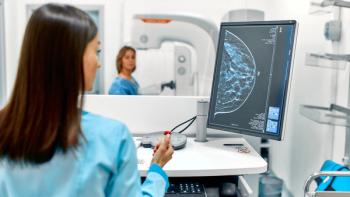
- March 2018
- Volume 12
- Issue 2
Promoting BRCA Awareness
By taking the nonthreatening approach of consulting a genetic counselor, plus the simple act of sending out a freshly collected 1-cc sample of saliva, I will affect not only my health but also the well-being of my daughters, son, and grandchildren.
I recall asking my mother’s oncologist in 1997, when BRCA gene testing was still in its infancy, about the possibility of testing her blood for this genetic mutation or freezing and storing her blood for future analysis. My mother was dying from recurrent metastatic breast cancer and, 5 years ear­lier, had been treated for primary ovarian cancer. As a fam­ily nurse practitioner, I was not only interested in this new testing for the sake of science but also personally concerned that my older sister, brother, and I might have inherited an increased risk of cancer associated with this genetic anomaly. My inquiry was dismissed with the nonchalant response that BRCA testing was just “too new to worry about right now.” In retrospect, a definitive result for my mother back then would have guided future healthcare recommendations for us.
After recently viewing the 2015 documentary Pink & Blue: Colors of Hereditary Cancer, I began to question why I had not sought genetic testing for the last 20 years. Pink & Blue not only educates the viewer about the BRCA gene mutations but also powerfully highlights the personal stories of both women and men with positive mutations, depicting their subse­quent journeys, including treatment, restoration, remission, or death. The documentary advocates that “knowledge is power” and speaks passionately about the need for increased awareness of genetic testing and breast cancer prevention.
One goal of Pink & Blue is to raise awareness of male breast cancer. Despite the overwhelming “pinkness” of the breast cancer world, men inherit BRCA mutations as fre­quently as women do. Regardless of gender, a parent with an inherited mutation has a 50% chance of passing it on to each of their offspring, whether the baby is a girl or boy.1 It struck me that if I were BRCA-positive, even my son could have a genetic mutation that might be transmitted to his children someday.
Up to 10% of all breast cancers may be linked to genetic mutations, with BRCA1/2 being the most common.2 A woman with a BRCA1/2 genetic anomaly may have up to an 80% lifetime risk of developing breast cancer, as well as ovarian, colon, skin, and pancreatic cancers. Although breast cancer is rare in men, the American Cancer Society estimated that about 2470 new cases of male invasive breast cancer were diagnosed in 2017 and that about 460 men would die from the disease.3 The average lifetime risk of breast cancer in men is about 1 in 1000 (0.1%) compared with 1 in 8 (about 12%) for women. A man with an abnormal BRCA2 gene has a life­time breast cancer risk of about 8%, 80 times greater than that of the average man without a genetic mutation, and is 7 times more likely to develop prostate cancer than men without an abnormal gene.4 Although survival rates are simi­lar for men and women with the same stage of breast cancer, men are often diagnosed at a later stage. This is often because men did not report early symptoms and/or the cancer spread to adjacent structures due to less breast tissue.5 Healthcare providers routinely document medical histories and cancer risk of their patients, but many do not always refer high-risk patients, including men, for genetic counseling or testing.
Genetic counseling and subsequent testing require serious consideration. Some individuals may not wish to have addi­tional medical testing or recommended prophylactic sur­gery if faced with the knowledge of a positive result. Because genetic mutations affect all biological relatives, there may be emotional tension and fear within the family, factoring into decisions regarding marriage, childbearing, and career choices. Fear, hesitation, and doubt abound in the areas of employment discrimination; potentially higher health, life, and mortgage insurance rates; test reliability; and financial coverage for genetic testing. Individuals who may have posi­tive genetic mutations might also experience feelings of guilt and loss of control. However, the federal Genetic Information Nondiscrimination Act of 2008, along with many state laws, prohibits discrimination based on genetic information in rela­tion to health insurance and employment, although it does not cover life insurance, disability insurance, or long-term care insurance.6
In addition to films like Pink & Blue, many online resources address cancer risk. A risk calculator on Bright Pink, a national nonprofit organization (BrightPink.org), quickly pro­vides information regarding the user’s chances of developing breast or ovarian cancer. The Male Breast Cancer Coalition, a nonprofit organization, reminds the public that “men have breasts, too” and offers a related series (HISbreastcancer.org). Both organizations add blue to the traditional pink ribbon to recognize breast cancer in both genders.
Today, I am bold enough to pursue genetic counseling and testing for not only BRCA1/2 but also the comprehensive 34-gene panel that may identify my risk of as many as 8 dif­ferent cancers. My decision was based on neither my own 25 years’ experience and medical knowledge as a nurse prac­titioner nor my healthcare providers’ prompting. It was made after I viewed Pink & Blue and heard the powerful stories of people whose lives were positively changed by knowledge of their genetics. By taking the nonthreatening approach of consulting a genetic counselor, plus the simple act of sending out a freshly collected 1-cc sample of saliva, I will affect not only my health but also the well-being of my daughters, son, and grandchildren.
Some high-risk individuals might also be stirred to action by modalities such as film, social media, websites, and blogs. But why is it that we as healthcare providers do not consistently promote awareness of breast cancer risk to both women and men, as well as genetic counseling referral (when indicated) to our patients? When taking the family medical history, we all can address breast cancer risk, symptom recognition, and pre­vention. A caring, sensitive attitude is crucial to dispel myths and alleviate fears, especially those of a man who may feel emasculated by talk of self-breast exam, areolar masses, and nipple discharge. When indicated, providers must encourage patients with multiple breast cancer risk factors, regardless of gender, to consider genetic counseling and/or BRCA testing. For those who opt for testing, the results, whether negative or positive, not only deliver the power of knowledge but also afford healthcare providers the ability to make better manage­ment and treatment decisions.
Donna R. White, DNP, RN, CRNP, FNP-BC, is the director of graduate clinical faculty and clinical affairs at Duquesne University School of Nursing in Pittsburgh, PA.
References
1. Senapathy K. “Pink & Blue” documentary challenges female only myths about breast cancer and BRCA mutations. Genetic Literacy Project website. geneticliteracyproject.org/2015/06/08/pink-blue-documentary-challenges-female-only-myths-about-breast-cancer-and-brca-mutations. Published June 8, 2015. September 17, 2017.
2. U.S. Breast Cancer Statistics. BreastCancer.org website. breastcancer.org/symptoms/understand_bc/statistics. Modified January 9, 2018. Accessed September 15, 2017.
3. Siegel RL, Miller KD, Jemal A. Cancer statistics, 2017. CA Cancer J Clin. 2017;67(1):7-30. doi: 10.3322/caac.21387.
4. Genetics. BreastCancer.org website.
5. Can breast cancer in men be found early? ACS website.
6. BRCA1 and BRCA2: cancer risk and genetic testing. National Cancer Institute website.
Articles in this issue
over 7 years ago
Sex After Cancer: Let Patients Know They Are Not Alonealmost 8 years ago
Oncology Case Management: Optimizing Care Pathwaysalmost 8 years ago
Nurses Find Meaning and Purpose After Retirementalmost 8 years ago
Raising a Red Flag: Patient Favoritismalmost 8 years ago
Let's Talk About Sex, Fertility, and Intimacy After Canceralmost 8 years ago
Cancer Treatment to the Wrong Patient: Why Does This Still Happen?Newsletter
Knowledge is power. Don’t miss the most recent breakthroughs in cancer care.




